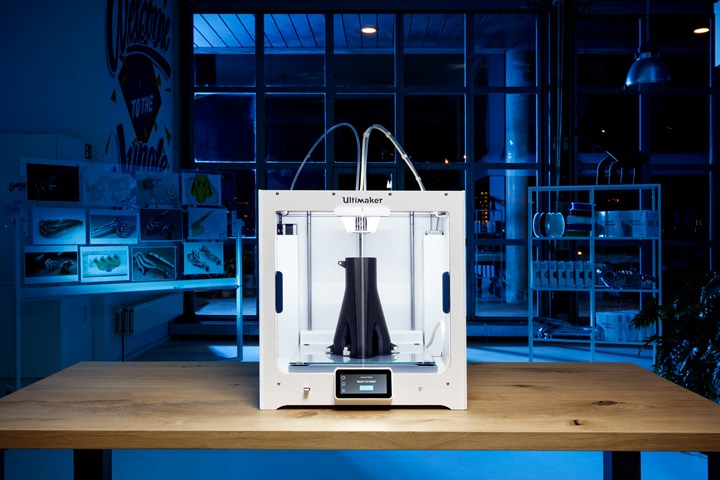Desktop 3D printing companies MakerBot and Ultimaker agree to merger
The new entity will maintain headquarters in New York, U.S. and the Netherlands, with respective CEOs serving as co-CEOs.

Ultimaker S5 printer.
Photo Credit: Ultimaker
Desktop 3D printing companies MakerBot (Brooklyn, N.Y., U.S.) and Ultimaker (Utrecht, Netherlands) announced on May 12 that they will merge as one entity, with the goal of accelerating the adoption of additive manufacturing by providing a comprehensive desktop 3D printing ecosystem of hardware, software and materials.
The new entity will be backed by existing investors, NPM Capital and Stratasys (Eden Prairie, Minn., U.S.), and will benefit from a planned cash investment of $62.4 million to fuel innovation and expansion into new markets.
The new company will be led by Nadav Goshen, current MakerBot CEO, and Jürgen von Hollen, current Ultimaker CEO, who will act as co-CEOs, with Goshen managing operations and R&D and von Hollen managing the commercial functions.
“This merger marks an important milestone for Ultimaker and MakerBot,” says von Hollen. “Innovation and growth are both critical to bringing desktop 3D printing from a specialty technology into mainstream business adoption. The new company will leverage and expand its combined global footprint with sales and operations in the Americas, EMEA and APAC.”
“Technological innovation is paramount in growing the availability of easy-to-use professional 3D printing solutions,” says Goshen. “By combining our teams and leveraging the additional funding, we can accelerate the development of advanced solutions to provide our customers with a broad portfolio of hardware and software solutions to serve a wide spectrum of customers and applications."
The new entity aims to offer easy-to-use and accessible desktop 3D printing solutions for any application while inspiring the industry to a future state of responsible and sustainable manufacturing.
The new company will maintain headquarters in both the Netherlands and New York, U.S. The transaction is subject to consultation of appropriate employee representative bodies and regulatory approvals, with closing currently expected over the course of the second or third quarters of 2022.
Related Content
-
Combining multifunctional thermoplastic composites, additive manufacturing for next-gen airframe structures
The DOMMINIO project combines AFP with 3D printed gyroid cores, embedded SHM sensors and smart materials for induction-driven disassembly of parts at end of life.
-
TU Munich develops cuboidal conformable tanks using carbon fiber composites for increased hydrogen storage
Flat tank enabling standard platform for BEV and FCEV uses thermoplastic and thermoset composites, overwrapped skeleton design in pursuit of 25% more H2 storage.
-
A new era for ceramic matrix composites
CMC is expanding, with new fiber production in Europe, faster processes and higher temperature materials enabling applications for industry, hypersonics and New Space.

.jpg;width=70;height=70;mode=crop)














